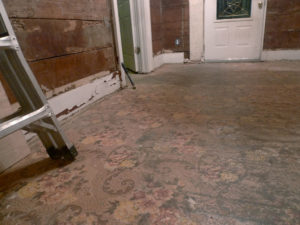 Linoleum flooring removal. Three words which can easily cause anyone to go into a panic. If you’ve done it before, you know precisely what this means, if you haven’t, you’re in for a labor-intensive experience that rivals practically any home improvement project. This is due to the fact of how linoleum flooring is installed (it’s meant to stay put for life). So, it isn’t exactly a walk in the park to take it out and that’s just the half of it, by the way — there’s another challenge — linoleum flooring disposal.
Linoleum flooring removal. Three words which can easily cause anyone to go into a panic. If you’ve done it before, you know precisely what this means, if you haven’t, you’re in for a labor-intensive experience that rivals practically any home improvement project. This is due to the fact of how linoleum flooring is installed (it’s meant to stay put for life). So, it isn’t exactly a walk in the park to take it out and that’s just the half of it, by the way — there’s another challenge — linoleum flooring disposal.
Linoleum Flooring Disposal
Like most big home improvements, linoleum flooring removal is serious business. Not because it requires a host of specialized tools or skills. But, because it’s just difficult. It’s very work intensive and takes a whole lot of time and effort to get it done. And, also like a number of renovations, you’ll need to plan in advance for what to do with the remodeling debris.
One of the most frustrating home remodeling tasks is trying to remove an old linoleum or vinyl floor. Even when the linoleum is pulled off, things only get worse. Now you’re faced with gobs of old glue that seem harder than meteorites all over the floor. —Improvement.com
This is due to the fact that linoleum flooring can contain hazardous materials, like asbestos. For older homes, this is more likely and that means you can’t just toss it out on the curb or even put it in a dumpster you rent. It’s best to have a junk removal service come and pick it up, instead. This way, you won’t have to deal with the hauling or disposal.
Alamo Oaks Linoleum Flooring Removal
Now, as for the linoleum flooring removal, that’s a simple process but it will take a lot of time and effort. It’s not an easy task to take on and you’ll need a couple of helping hands. (Also, a few tools and materials to get the job done.) Here’s an overview of how to do linoleum flooring removal:
- Test for asbestos first. There’s a possibility that linoleum flooring can contain asbestos. So, don’t take a chance and test for the substance before you do anything else. If it tests positive, you’ll need to bring in a professional crew.
- Pull the linoleum up. As for the actual linoleum flooring removal, it starts in a corner. Pick a corner and use a knife and/or needle nose pliers to begin to peel it up from the subfloor underneath. Once you have part of it up, then pull up the rest gradually.
- Remove the adhesive. Next, you’ll need to remove any leftover adhesive residue from the subfloor. You can use a solvent for this, along with a floor scraper to get it all.
- Clean the subfloor to finish. Lastly, you’ll need to clean and disinfect the subfloor and then let it dry before you cover it with replacement flooring.
When it’s time for remodeling debris removal, just phone 800-433-1094 or visit Pro Junk Dispatch.


